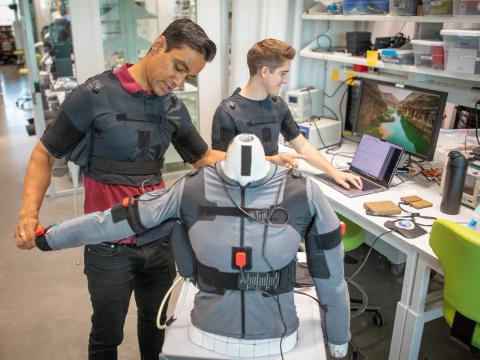Officials Working to Deliver Innovation to DOD's Information Technology Environment
The U.S. House of Representatives is examining the status of the Defense Department’s information technology, modernization efforts and strategic direction. The House Armed Forces Committee’s Subcommittee on Intelligence and Emerging Threats and Capabilities, led by ranking member Rep. James Langevin (D-R.I.), held a hearing on February 26, with top DOD IT leaders testifying.
“The Defense Department’s IT infrastructure is as important to the mission as the weapons platforms that our service members employ,” said Rep. Langevin. “We cannot expect the services to maintain combat superiority if the technology that we rely on is deficient, outdated, unsecure or inoperable.”
Congress has taken steps to make sure the DOD is structured to support senior leaders’ effort in managing IT, the subcommittee's ranking member said. It created the chief management officer (CMO) position and assigned the CMO with business systems responsibilities. In addition, Congress gave the DOD’s chief information officer (CIO) position new standards setting and budgetary authorities, which took effect on January 1.
The subcommittee held the hearing to look at how the DOD was implementing these new roles, in addition to hearing the status of IT efforts.
Lisa Hershman, acting CMO, has the responsibility to deliver optimized business operations within the department. Hershman reported to the subcommittee that the CMO office is aggressively working to reform and modernize business operations and perform monumental changes in management of data throughout the enterprise.
“The elevation of the CMO as the number three in the department,” as well as the increased authorities from Congress, are making reforms possible, she said. “My goal as the acting CMO aligns directly with the National Defense Authorization Act: efficiency for lethality,” Hershman said. The CMO’s office has been working with the DOD comptroller and other departments on improvements, claiming $4.7 billion in program savings. They also have conducted the first departmentwide financial audit.
The DOD’s business system, IT infrastructure and data management hold great potential for improvement, Hershman acknowledged. “Our current IT and business systems environment is extremely complex, with hundreds of business systems, thousands of data centers, hundreds of cloud efforts, thousands applications, in addition to 65 CIOs,” she noted. “Its extremely difficult for us to deliver an effective innovative and secure IT environment.”
The CMO’s office will continue to focus on three reform priorities: eliminating redundant systems, maximizing shared service delivery and streamlining business operations in areas like procurement, Hershman stated. Common enterprise data will see improvements, she added. The CMO has hired DOD’s first chief data officer, a move that will improve the department’s data management. Michael Conlin, a former chief technology officer with DXC Technology, stepped into the DOD data role last summer.
Meanwhile, DOD CIO Dana Deasy told the subcommittee that the CIO’s office will continue to focus on implementing cloud, artificial intelligence (AI), command, control and communications (C3) improvements, IT reforms and cybersecurity.
The new authorities granted by Congress have allowed the CIO to review and certify all IT budgets across the DOD, including cyber, Deasy noted. The DOD CIO now has the authority to set and enforce IT standards across the department, which will be an important tool for innovation, he said.
As for cloud, over the long term, the department will retain a multicloud environment with both general purpose and fit-for-purpose cloud platforms, Deasy emphasized. Earlier in February, the CIO released the department’s cloud strategy, which is being implemented. Deasy defended the Joint Enterprise Defense Infrastructure (JEDI) effort as a “pathfinder, general purpose, enterprise-wide cloud. As a part of the cloud strategy, JEDI will enable the DOD to learn to implement enterprise cloud solutions, taking advantage of economies of scale and enhance data-driven decision-making, he said.
The department is setting its sights on the Joint Artificial Intelligence Center (JAIC) to implement AI. “JAIC will accelerate the DOD’s delivery and adoption of AI,” Deasy told the subcommittee.
Because the nature of warfare is changing, and the emergence of digital technologies is altering the C3 landscape, DOD’s C3 systems must be modified and modernized, Deasy stressed. And the DOD will work with Undersecretary of Defense for Research and Engineering Michael Griffin and other federal partners to implement 5G.
In addition, the CIO is working with the Defense Information Systems Agency and other key officials to carry out the DOD’s cyber strategy, released last September. The leaders have developed a “Cyber Top 10 list,” which helps them prioritize their efforts “within a complex cyber landscape,” Deasy explained. It outlines where and how they will apply resources, such as remediation to information networks or risk management analysis.
Brig. Gen. Dennis Crall, USMC, deputy principal cyber advisor in the Office of the Secretary of Defense, updated the subcommittee on the DOD’s efforts to identify and address cybersecurity lapses.
Gen. Crall leads the Office of the Principal Cyber Advisor’s cross-functional team (CFT) charged with closing the cybersecurity gaps, and is initially confident about the CFT’s efforts. “The measure of our effectiveness has yet to be proven but I’m optimistic that we’ll get to where we need to be,” he said. “Congress has done us well to establish the CFT.”





Comments